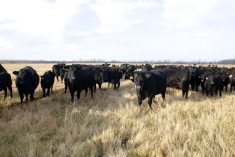BRANDON — In the early 1980s, zero tillage was just underway in Canada. A small band of progressive farmers had stopped tilling their land but the majority of growers were still turning the soil black.
By 2011, everything changed.
More than 56 percent of Canadian farmland was seeded without tillage and 25 percent was managed with conservation tillage.
David Montgomery, a University of Washington geologist, is hoping that something similar happens with regenerative agriculture.
“I think the biggest potential for transforming modern agriculture is to turn what we now have, as conventional agriculture, into regenerative agriculture,” said Montgomery, author of the book Dirt: The Erosion of Civilizations and the keynote speaker at the Regenerative Agriculture Conference, held late November in Brandon.
Read Also

Farming Smarter receives financial boost from Alberta government for potato research
Farming Smarter near Lethbridge got a boost to its research equipment, thanks to the Alberta government’s increase in funding for research associations.
“What I’m advocating is marrying ancient wisdom of crop rotations and diversity of crops with the modern technology that allows us to do no-till…. It isn’t a rejection of modern science. It’s an argument for adapting (agriculture) to what we now know.”
Currently, only a tiny percentage of Canadian and American farmers have adopted the basic principles of regenerative agriculture — minimal soil disturbance, covering the soil with plants as much as possible and diverse crop rotations to break the cycle of disease and pests.
Such farmers still use pesticides, genetically modified crops, fertilizer and other tools of modern ag, but at the centre of regenerative ag is a belief that healthy soil reduces dependence on crop inputs.
There are geographic pockets in the northern U.S. Plains, such as Bismarck, N.D., and parts of South Dakota, where such practices are becoming common.
Brooks White, who farms near Lyleton, Man., has been practicing regenerative agriculture on his 7,500-acre mixed farm for more than five years. He has experimented with intercropping and has integrated bison into his cropping system, which includes cover crops, soybeans, fababeans, peas, canola and lentils. The changes have improved soil productivity and cut costs.
“On my numbers we’re showing we can be more profitable in this regenerative system,” White said in May 2018. “We may be looking at reducing yields but being more profitable while doing that.”
Montgomery has met with dozens of farmers like White who are trying to improve soil health with cover crops, diverse rotations and minimal tillage.
He believes it could represent what he calls a “fifth revolution” in agriculture, the others being:
- planting things: cultivation and tillage
- soil husbandry: legumes and crop rotation
- mechanization and industrialization (1900s)
- green revolution and biotechnology (1970 to present)
- soil health, integrating modern science and soil husbandry (2018 and onward)
Montgomery has some credibility on this topic because of his resumé. He has won a MacArthur Fellowship, a prestigious award commonly known as a Genius Grant. And he’s used the success of his book Dirt to advocate for preserving and protecting the world’s soils.
He’s convinced that working in partnership with soil microbes, the fungi and bacteria in the soil, can make farming more efficient and sustainable.
The current system of adding inputs, like nitrogen, phosphorus and potassium, does boost yield but it also has negative consequences, he said.
“If the plant is getting all the major elements that it needs, it doesn’t tend to invest as much in its roots,” Montgomery said, explaining that plant roots release exudates, or sugars, that feed micro-organisms in the soil. Those soil fungi and bacteria, in exchange, provide nutrients and important compounds to the plant.
Over-fertilizing also makes plants less resilient and more susceptible to insects and disease, Montgomery said.
“What I think we’ve done is dismantled our plants’ defence systems … and (changed) the relationship with the microbiota in the soil,” he said. “When I went to graduate school that was crazy talk. Now … the science is coming out that supports that argument…. We’ve learned enough about microbial ecology in the last 20 years to re-think some of what we call conventional agriculture.”
Ryan Boyd, who farms north of Brandon, said it’s likely that hundreds of Canadian farmers are already practising some form of regenerative agriculture. The sales pitch of less inputs and higher profits will encourage more to try it, but the appeal is broader than dollars and cents.
“It’s liberating when you start embracing the principles of soil health and start thinking on a systems level (about) what you can accomplish. It’s not just relying on A, B, C inputs, add them together and hope the weather co-operates. It’s exciting to know you have that power … to be more in control.”
The audience of 250 at the Brandon conference was receptive to Montgomery’s message, but many Canadian producers may be skeptical that cover crops and diverse rotations can improve the profitability of their farm.
However, if one percent of farmers adopted regenerative agriculture each year, North American agriculture could look very different by 2050, Montgomery said.
Anything is possible, but supporters of regenerative agriculture must be careful with tone and language.
One of the weaknesses of organic farming is that some of its supporters, like Moms Across America, are loud and offensive. Their attacks don’t sit well with many conventional farmers who may feel they are under attack, so there can be tension between organic and conventional farmers.
Leaders of the soil health movement need to avoid an “us versus them” scenario, because branding regenerative ag as different from conventional is a risk.
“I think it is an issue and I am concerned,” said Kris Nichols, a former U.S. Department of Agriculture soil microbiologist who also spoke in Brandon. “Like the organic (movement) created a standard that can be used for marketing, the same is happening with regenerative, where they are trying to create a standard…. It does put people, potentially, into dysfunctional silos.”
Instead of creating a new segment and seeking a price premium for regenerative, it would be better if proponents made the tent as big as possible and invited everyone inside, Nichols added.
“This has to happen on a scale…. This isn’t about doing this for a small market,” said Nichols, who was the chief scientist with the Rodale Institute and now runs her own consultancy. “This is about millions of acres.”
Montgomery agrees.
Regenerative agriculture needs to attract as many producers as possible. And millions of acres may be possible because farmers are leading the movement.
“This emerging fifth revolution, as I call it … I see it mostly being driven from the bottom up,” Montgomery said. “(There’s) a lot of interest from producers on ways to reduce the cost of inputs (and) ways to ensure their land is in better shape, when their grandkids get it.”


















